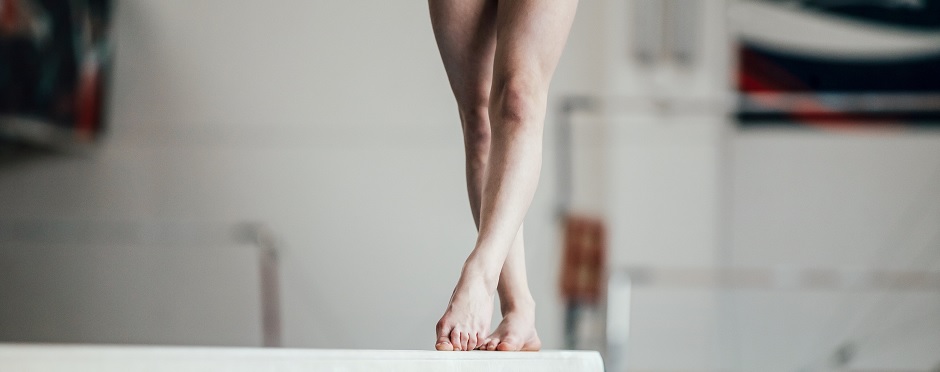
Knee Injuries Seen in Gymnasts
Leave a CommentKnee pain in young gymnasts is a common complaint. Many times these young athletes begin having pain due to overuse of the area. A common overuse injury is Osgood-Schlatter’s disease (OSD). OSD is inflammation of the patellar ligament below the kneecap. Often, there is a painful bump below the kneecap (the tibial tuberosity) where the ligament attaches.
What Causes OSD?
OSD is usually seen in children who are growing or undergoing a growth spurt. During running or jumping activities, the tendon of the quadriceps muscle pulls on the bone near the growth plate below the kneecap which can lead to irritation, pain, and swelling. Boys tend to experience OSD between the ages of 12-14 where girls tend to experience between the ages of 10-13.
Symptoms of OSD
- Pain below kneecap, on top of shin bone
- Pain is worse with activities
- Most pain occurs during running and jumping activities
- Swelling at tibial tubercle (below kneecap)
- Tight muscles in front or back of thigh
Treatment of OSD for Gymnasts
Oftentimes, OSD pain will resolve when children stop growing. However, physical therapy can help with the pain during the window in which symptoms are aggravated. Physical therapy can help with stretching of tight muscles that may be contributing to the symptoms. Furthermore, many young children can benefit from strengthening programs for hips and ankles to help decrease the stress across the painful knee joint.
For some children, a period of rest may be required to decrease inflammation. Limiting running and jumping activities as well as limiting participation in sports is an example of a rest period. Ice can also help with decreasing symptoms initially. Some children also benefit from a knee strap, which, when worn below the kneecap, can help relieve pain when performing activities.
Recommendations for Training
- Ensure that there is equal strength throughout your legs on both sides
- Focus on flexibility for both sides
- Stretch your quadriceps, hamstrings, and calf muscles
- Walking should be pain-free before returning to higher level activities such as running or tumbling
- Begin with light jogging and walking through any dance portions of your floor routine
- Practice proper jumping and landing mechanics
- When landing, toes should land first, then the ball of foot, then heels as if rolling through the foot. Also push the buttocks backward as if sitting into a chair to prevent knees from going forward past the toes for both landing and jump take off.
- Running to vault, tumbling, dismounts will be progressed to last
- Modifications to the landing surface like adding a sting mat and limiting number of repetitions may also be required when returning to sport-specific activities
Seek Treatment at the First Sign of Pain
If your young athlete beings to experience pain, don’t wait for it to resolve. Schedule a Free Assessment at an Athletico near you. Free Assessments are available in-clinic and virtually through our Telehealth platform.
Athletico provides rehabilitation services to gymnasts at all levels and abilities. Our goal is to evaluate, treat, and educate athletes in the prevention of practice and competition-related injuries. Technical evaluations can be performed to improve postural awareness and maximize the function of each athlete. We have physical therapists and athletic trainers, including former gymnasts and cheerleaders at the high school, collegiate and Olympic levels, involved with our Gymnastics and Cheerleading Program. Our clinicians understand the demands of the sport and use their personal and professional experience to effectively address the physical and psychological needs of each athlete.
For more information contact a Gymnastics and Cheerleading Rehabilitation Clinician by emailing Gymcheer@athletico.com.
The Athletico blog is an educational resource written by Athletico employees. Athletico bloggers are licensed professionals who abide by the code of ethics outlined by their respective professional associations. The content published in blog posts represents the opinion of the individual author based on their expertise and experience. The content provided in this blog is for informational purposes only, does not constitute medical advice and should not be relied on for making personal health decisions.
